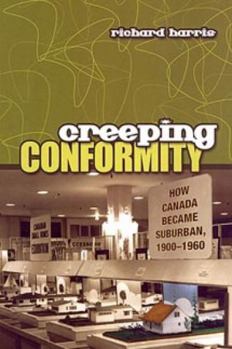Creeping Conformity: How Canada Became Suburban, 1900-1960
Select Format
Select Condition 
Book Overview
Creeping Conformity, the first history of suburbanization in Canada, provides a geographical perspective - both physical and social - on Canada's suburban past. Shaped by internal and external migration, decentralization of employment, and increased use of the streetcar and then the automobile, the rise of the suburb held great social promise, reflecting the aspirations of Canadian families for more domestic space and home ownership. After...
Format:Paperback
Language:English
ISBN:0802084281
ISBN13:9780802084286
Release Date:June 2004
Publisher:University of Toronto Press
Length:160 Pages
Weight:0.64 lbs.
Dimensions:0.6" x 5.6" x 8.5"
Customer Reviews
1 rating
shows how Canada became more like the USA
Published by Thriftbooks.com User , 14 years ago
This book describes the evolution of Canadian suburbia. In the early 20th century, territory outside the limits of major cities was usually occupied by working-class shantytowns; these areas were not popular with the well-to-do because of the absence of basic municipal services such as water and streetcars. Some residents of these suburbs commuted long distances; others were able to commute to nearby industrial jobs because even in the early 20th century, heavy industry needed more land than central cities could usually provide and relocated to industrial suburbs. Nevertheless, Canadian suburbs actually grew more slowly than cities for much of the early 20th century. To a greater extent than in the United States, cities rather than suburbs resisted city/suburb consolidation; major cities such as Toronto did not wish to pay the expenses of extending water and sewer into suburbs. After World War II, Canada massively increased government interference in the housing market. The Canada Mortgage and Housing Corporation (CMHA), much like American housing authorities, specified minimum street width and other standards that were required for federal support. (However, Harris doesn't really discuss these standards in detail; were they as sprawl-oriented as the standards set forth by U.S. housing agencies?) Because such financing was available only for new housing, CMHA and other Canadian agencies implicitly favored movement to suburbs with lots of open land. And because CMHA standards made it impossible to build unsantiary, unserviced shantytowns, suburban housing became more expensive and less working-class. The latter trend was bolstered towards the Canadian trend towards adopting zoning ordinances and comprehensive plans; these plans, like their American counterparts, tended to favor rigid separation of land uses, as well as higher standards of housing quality. Ultimately, Canadian government finance and municipal land use regulation made Canadian suburbs somewhat more like American suburbs: affluent and car-dependent.





